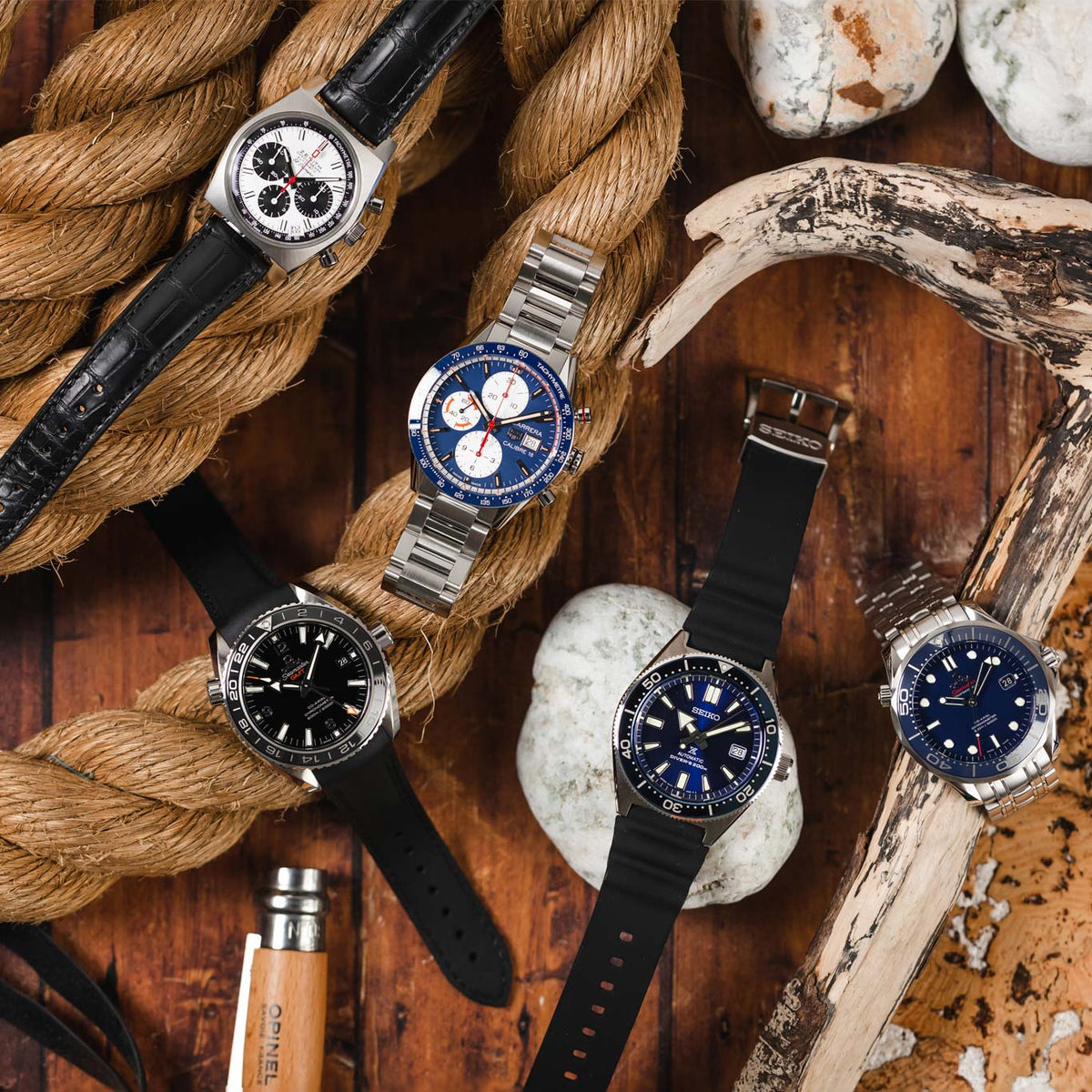The Ultimate Guide to Watch Water Resistance

Whether you’re a watch enthusiast or the proud owner of just one timepiece, you will have heard or seen the term water resistant used in regards to watches. Water resistance refers to the extent to which a watch can withstand splashes of water, and pressure in or under water. To tell consumers how water resistant a watch is, individual watches are given a water resistance score (listed as depths or pressure), which appears on the watch dial (often in metres).
It is a common misconception that water resistant watches can be taken to the water depth of the metres that are specified (e.g. that a 30 metre watch can be taken to 30m water depth). Instead, the metres refers to the results of a static pressure test undertaken in a laboratory environment. Unless a watch is designed for deep sea exploration, then it is not meant for prolonged use underwater. A watch marked as watch-resistant that is not a dive watch, regardless of its metres, is still designed just for accidental splashes or short submersions.

There is an additional level of standardisation from the International Organisation of Standards to keep in mind too. ISO 2281 — which refers to the designation, requirements, test methods and marking of water-resistant watches — and ISO 6425, the standards for a dive watch.
Water-Resistant vs. Waterproof Watch?
Vintage watches might say “waterproof” on the back. However, in 1990, ISO 22810:2010 — which established the requirements and specified the test methods used to confirm the water resistance of watches — banned the use of the word as no watch can be 100% waterproof. With sufficient pressure, all watches can leak, so no watches can be considered waterproof.
Water Resistance Rankings
Now let's break down what the metres mean, and what watches are suitable for what wet activities — with features from some of our favourite water-resistant watches.
30m
Suitable for washing hands and light splashes.
A 30-metre (or 3 Bar) watch is the minimum standard to be considered water-resistant. These watches are designed for accidental daily splashes — a bit of rain or some light drops when washing your hands — but are not suitable for submersion in water (of any amount or for any period of time).
This is a common water resistance level, and one you would expect to find on lots of fashion watches.
50m
Suitable for gentle and short submersion.
A 50-metre (or 5 Bar) watch, on the other hand, is OK to be submerged for short periods. You should be fine to go for a gentle swim in the pool, for example, but we would advise that you don't dive (or even go in the jacuzzi) because of the pressure.
Remember that a watch’s water resistance isn’t just about moisture, it’s about changes in pressure too. Diving in a pool can cause an abrupt change in pressure, which will shock your watch and push it past its water resistance (breaking the watch). For similar reasons, a 50m watch is not suitable for water sports.

The ZENITH 03.A384.400/385.C855 Chronomaster Revival El Primero and the ZENITH 03.A384.400/21.C815 Chronomaster Revival El Primero — faithful reproductions of the very first Zenith watch in steel to feature the El Primero high-frequency automatic chronograph calibre from 1969.
100m
Suitable for recreational surfing, swimming, snorkelling, sailing and water sports.
Swimming, snorkelling, surfing, and boat trips should all be possible with a 100m (or 10 Bar) watch. To err on the side of caution, this is a good alternative to the 50m (in terms of water resistance). You should still avoid diving or other activities that will shock your watch with the pressure changes though.
200m
Suitable for professional marine activity and serious surface water sports.
From this point on (watches with over 200 metres of water resistance), you can use these watches when you dive.

The DOXA 799.10.101.LE.10 Sub 200 130th Anniversary 42mm Automatic Watch and SEIKO Prospex Automatic Men's Diver Watch are popular dive watches.

The LONGINES L2.822.4.56.6 Skin Diver 42mm Automatic Watch and OMEGA 212.30.41.20.03.001 Seamaster No-Wave 41mm Automatic Watch are excellent 300m watches.
600m - 1000m
Most watches above 600m are suitable for all water activities.

The OMEGA 215.30.40.20.03.001 Seamaster Planet Ocean 39.5mm Co-Axial Master Chronometer and OMEGA 232.32.44.22.01.001 Seamaster Planet Ocean 600m GMT 43.5mm Co-Axial Master Chronometer are popular choices for deep sea divers.
Please note that all watches (yes, even 1000m ones) should be kept away from humid conditions as this can permeate the watch and allow moisture into the movement.
Dive Watches
As their name suggests, Dive Watches are specifically designed and engineered for heavy water usage and can withstand depths of at least 200 metres. Unlike a non-dive watch, there are minimal openings for water to permeate, with a sturdier case, screw-down crown, and heavier gaskets for additional protection. For people who spend a lot of time in or on the water, dive watches are an essential.
For a dive watch to be considered an official dive watch, it needs to be compliant with ISO 6425. There are lots of tests involved, but this includes measuring a watch's:
- Resistance to Salt Water
- Reliability Under Water
- Reaction to Condensation
- Reaction to Extreme Water Temperature Changes
It’s important that you test your dive watch at least once a year — more if you’re in the water multiple times a week — to make sure that its water resistance is maintained. Gaskets will need to be replaced and lubricated, and salt water can cause faster corrosion than you might expect.
⌚
Need a water resistant strap to match? Check out our website, or read our guide on the best summer watch straps, which features a selection of the best water-resistant straps for the hot months.
We are WatchObsession, your favourite watch strap store since 2010. Shop our luxury watches, watch straps and watch tools and accessories on our website and become #WObsessed.